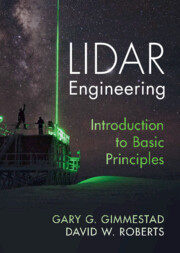Refine search
Actions for selected content:
28 results
5 - Digital Signal Processing for RFID Applications
-
- Book:
- Radio Frequency Identification Engineering
- Published online:
- 02 January 2025
- Print publication:
- 09 January 2025, pp 93-130
-
- Chapter
- Export citation

Radio Frequency Identification Engineering
- How to Engineer an RFID Reader
-
- Published online:
- 02 January 2025
- Print publication:
- 09 January 2025

Linear Algebra for Data Science, Machine Learning, and Signal Processing
-
- Published online:
- 01 November 2024
- Print publication:
- 16 May 2024
-
- Textbook
- Export citation

Lidar Engineering
- Introduction to Basic Principles
-
- Published online:
- 16 February 2023
- Print publication:
- 23 February 2023
6 - Fault Identification from Seismology
- from Part II - Methods and Techniques for Fault Identification and Dating
-
-
- Book:
- Glacially-Triggered Faulting
- Published online:
- 02 December 2021
- Print publication:
- 16 December 2021, pp 100-117
-
- Chapter
- Export citation
Morphological and electrophysiological specializations of photoreceptors in the love spot of hover fly Volucella pellucens
-
- Journal:
- Visual Neuroscience / Volume 38 / 2021
- Published online by Cambridge University Press:
- 12 October 2021, E015
-
- Article
- Export citation
1 - Linear Systems: What You Missed the First Time
-
- Book:
- A Guide to Feedback Theory
- Published online:
- 09 April 2021
- Print publication:
- 22 April 2021, pp 1-51
-
- Chapter
- Export citation

Advanced Data Analytics for Power Systems
-
- Published online:
- 22 March 2021
- Print publication:
- 08 April 2021
Analysis of impact of group delay on slope distortion of S-curve in delay locked loop
-
- Journal:
- The Journal of Navigation / Volume 74 / Issue 3 / May 2021
- Published online by Cambridge University Press:
- 09 February 2021, pp. 698-712
- Print publication:
- May 2021
-
- Article
- Export citation
3 - Circuit and Antenna Designs for Ambient Backscatter
- from Part I - Fundamentals of Ambient Backscatter Communication
-
- Book:
- Ambient Backscatter Communication Networks
- Published online:
- 24 April 2020
- Print publication:
- 30 April 2020, pp 62-96
-
- Chapter
- Export citation
Detection of Intermediate Spoofing Attack on Global Navigation Satellite System Receiver Through Slope Based Metrics
-
- Journal:
- The Journal of Navigation / Volume 73 / Issue 5 / September 2020
- Published online by Cambridge University Press:
- 03 April 2020, pp. 1052-1068
- Print publication:
- September 2020
-
- Article
- Export citation
1 - Introduction
-
- Book:
- Explorations in Time-Frequency Analysis
- Published online:
- 22 August 2018
- Print publication:
- 06 September 2018, pp 1-6
-
- Chapter
- Export citation
NOVEL PREPROCESSING APPROACHES FOR OMICS DATA TYPES AND THEIR PERFORMANCE EVALUATION
- Part of
-
- Journal:
- Bulletin of the Australian Mathematical Society / Volume 96 / Issue 2 / October 2017
- Published online by Cambridge University Press:
- 05 July 2017, pp. 348-349
- Print publication:
- October 2017
-
- Article
-
- You have access
- Export citation
X-ray Pulsar/Starlight Doppler Deeply-integrated Navigation Method
-
- Journal:
- The Journal of Navigation / Volume 70 / Issue 4 / July 2017
- Published online by Cambridge University Press:
- 09 March 2017, pp. 829-846
- Print publication:
- July 2017
-
- Article
- Export citation
Signal processing and analog/RF circuit design: cross-discipline interactions and technical challenges
-
- Journal:
- APSIPA Transactions on Signal and Information Processing / Volume 5 / 2016
- Published online by Cambridge University Press:
- 06 June 2016, e12
- Print publication:
- 2016
-
- Article
-
- You have access
- Open access
- HTML
- Export citation
Pulse Phase Estimation of X-ray Pulsar with the Aid of Vehicle Orbital Dynamics
-
- Journal:
- The Journal of Navigation / Volume 69 / Issue 2 / March 2016
- Published online by Cambridge University Press:
- 06 October 2015, pp. 414-432
- Print publication:
- March 2016
-
- Article
-
- You have access
- HTML
- Export citation
Automation of fault diagnosis of bearing by application of fuzzy inference system (FIS)
-
- Journal:
- Mechanics & Industry / Volume 15 / Issue 6 / 2014
- Published online by Cambridge University Press:
- 01 September 2014, pp. 477-485
- Print publication:
- 2014
-
- Article
- Export citation
Radio Frequency Interference Mitigation Strategies: Summary of the E. & F. White Conference held in Sydney, Australia, December 1999
-
- Journal:
- Publications of the Astronomical Society of Australia / Volume 17 / Issue 3 / 2000
- Published online by Cambridge University Press:
- 05 March 2013, pp. 255-259
-
- Article
-
- You have access
- Export citation
